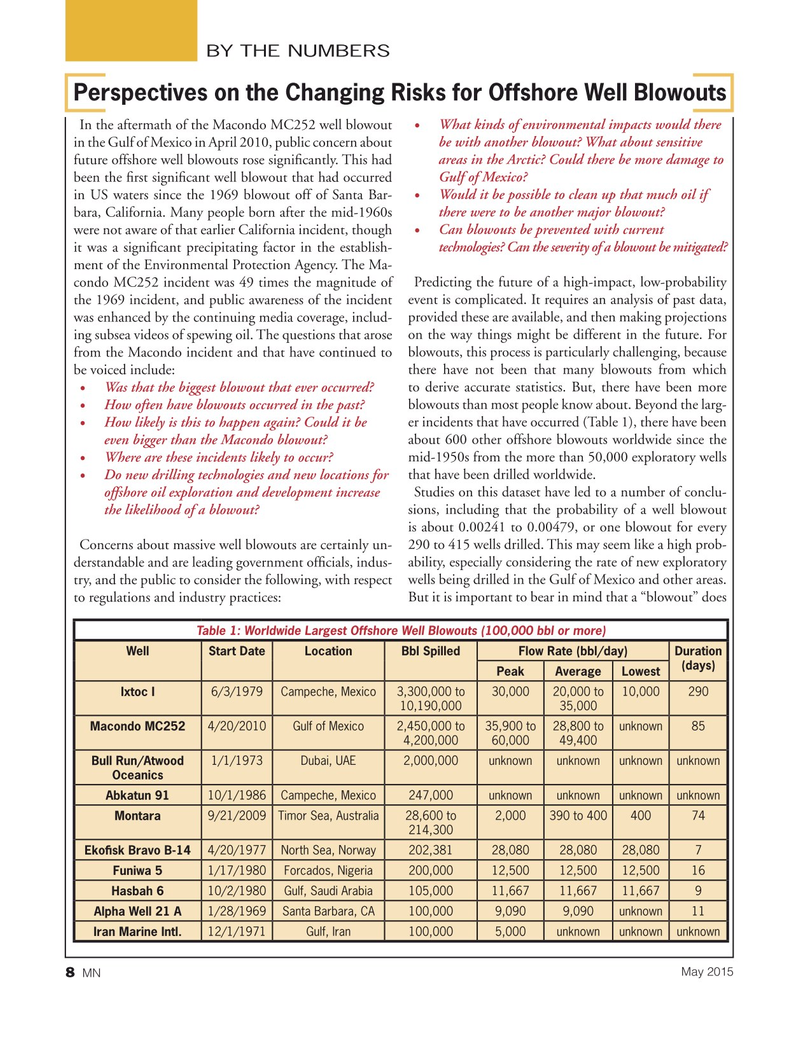
Page 8: of Marine News Magazine (May 2015)
Offshore Annual
Read this page in Pdf, Flash or Html5 edition of May 2015 Marine News Magazine
BY THE NUMBERS
Perspectives on the Changing Risks for Offshore Well Blowouts •
In the aftermath of the Macondo MC252 well blowout What kinds of environmental impacts would there in the Gulf of Mexico in April 2010, public concern about be with another blowout? What about sensitive future offshore well blowouts rose signi? cantly. This had areas in the Arctic? Could there be more damage to been the ? rst signi? cant well blowout that had occurred Gulf of Mexico?
• in US waters since the 1969 blowout off of Santa Bar- Would it be possible to clean up that much oil if bara, California. Many people born after the mid-1960s there were to be another major blowout?
• were not aware of that earlier California incident, though Can blowouts be prevented with current it was a signi? cant precipitating factor in the establish- technologies? Can the severity of a blowout be mitigated?
ment of the Environmental Protection Agency. The Ma- condo MC252 incident was 49 times the magnitude of Predicting the future of a high-impact, low-probability the 1969 incident, and public awareness of the incident event is complicated. It requires an analysis of past data, was enhanced by the continuing media coverage, includ- provided these are available, and then making projections ing subsea videos of spewing oil. The questions that arose on the way things might be different in the future. For from the Macondo incident and that have continued to blowouts, this process is particularly challenging, because be voiced include: there have not been that many blowouts from which • Was that the biggest blowout that ever occurred? to derive accurate statistics. But, there have been more • How often have blowouts occurred in the past? blowouts than most people know about. Beyond the larg- • How likely is this to happen again? Could it be er incidents that have occurred (Table 1), there have been even bigger than the Macondo blowout? about 600 other offshore blowouts worldwide since the • Where are these incidents likely to occur? mid-1950s from the more than 50,000 exploratory wells • Do new drilling technologies and new locations for that have been drilled worldwide.
offshore oil exploration and development increase Studies on this dataset have led to a number of conclu- the likelihood of a blowout? sions, including that the probability of a well blowout is about 0.00241 to 0.00479, or one blowout for every
Concerns about massive well blowouts are certainly un- 290 to 415 wells drilled. This may seem like a high prob- derstandable and are leading government of? cials, indus- ability, especially considering the rate of new exploratory try, and the public to consider the following, with respect wells being drilled in the Gulf of Mexico and other areas. to regulations and industry practices: But it is important to bear in mind that a “blowout” does
Table 1: Worldwide Largest Offshore Well Blowouts (100,000 bbl or more)
WellStart DateLocationBbl SpilledFlow Rate (bbl/day)Duration (days)
Peak AverageLowest
Ixtoc I 6/3/1979Campeche, Mexico3,300,000 to 30,00020,000 to 10,000290 10,190,000 35,000
Macondo MC252 4/20/2010Gulf of Mexico2,450,000 to 35,900 to 28,800 to unknown85 4,200,000 60,000 49,400
Bull Run/Atwood 1/1/1973Dubai, UAE2,000,000unknownunknownunknownunknown
Oceanics
Abkatun 91 10/1/1986Campeche, Mexico247,000unknownunknownunknownunknown
Montara 9/21/2009Timor Sea, Australia28,600 to 2,000390 to 40040074 214,300
Eko? sk Bravo B-14 4/20/1977North Sea, Norway202,38128,08028,08028,0807
Funiwa 5 1/17/1980Forcados, Nigeria200,00012,50012,50012,50016
Hasbah 6 10/2/1980Gulf, Saudi Arabia105,00011,66711,66711,6679
Alpha Well 21 A 1/28/1969Santa Barbara, CA100,0009,0909,090unknown11
Iran Marine Intl. 12/1/1971Gulf, Iran100,0005,000unknownunknownunknown
May 2015 8
MN

 7
7

 9
9
